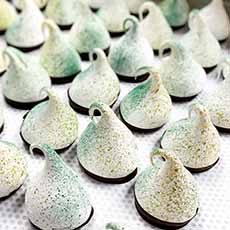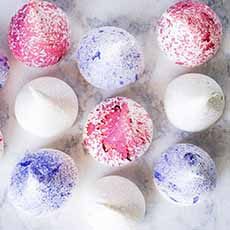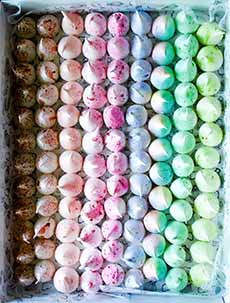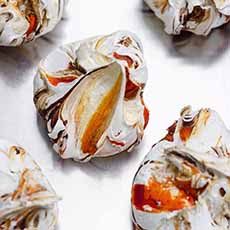RECIPE: Holiday Meringue Drops
|
Austin, Texas has become a hot city to visit and move to, abetted by its ever-expanding food scene. One place of interest is Fluff Meringues & More is a modern patisserie that proffers European treats in a market full of cupcakes and Southern pecan pie. A meringue cookie is the opposite of these latter favorites. The light fluffs of egg whites and sugar are cholesterol free, lower in calories and welcome at home on an assorted cookie plate, a dessert plate garnish or with after-dinner coffee and tea. At Fluff Meringues & More, you can have a civilized afternoon tea respite, with fetching pastries, scones, mousse, homemade marshmallows and of course, meringues. Put it on your go-to list for a visit to Austin. While you can see the wealth of meringue flavors in photo #3, Fluff Meringues & More has shared a holiday-inspired flavor with us: Vanilla Cardamom Pistachio Meringue Drops. Ingredients For Approximately 35 Drops 1. PREHEAT the oven to 400°F. Separate egg whites from the yolks, being sure not to allow any yolk to drip into the whites. Weigh the whites as you go. Reserve the yolks for another use). 2. WEIGH the sugar to match the 2:1 egg white ratio. Spread the sugar out on tray. Place in the oven and heat for 7-8 minutes. While the sugar is heating… 3. WHIP the egg whites in a stand mixer until they are stiff. Start on medium speed for 2 minutes, then move to high until stiff peaks form. 4. REMOVE the sugar from oven and reduce the oven temperature to 215°-230°. The oven will need to decrease in temperature quickly, so leaving the door open a bit for a few minutes helps. 5. BEGIN adding the sugar immediately. Initially spoon in large spoonfuls until 1/3 to 1/2 pf the mixture is gone. Let mix on high for 30 seconds, then start slowly streaming in the remainder of the sugar. 6. WHIP until all the granules are dissolved and the batter is stiff, tacky, and shiny. Add the cardamom and whip for 10-15 seconds. Add the vanilla and whip for 5-10 seconds. Don’t over-mix vanilla! 7. LOAD the meringue into a piping bag and pipe meringue drops onto a parchment-lined baking sheet. Bake for 50 minutes in the lower rack of the oven. Cool on rack for 20 minutes. While meringues are cooling… 8. HEAT the white chocolate in a double boiler (or very carefully in the microwave, at 30 seconds until melted. NOTE: If you burn the chocolate, you’ll have to start over. Stir and make sure the melted chocolate is smooth. 9. PLACE the crushed pistachios in a wide bowl. After the meringues are cool, delicately dip the bottoms of the drops into the melted chocolate, then dip into the pistachios. Place the dipped meringues back on a sheet of clean parchment paper and let them set for 15-20 minutes. Some sources say that that meringue was invented in the Swiss village of Meiringen in the 18th century, and improved by an Italian chef named Gasparini. Not all experts agree: The Oxford English Dictionary, for example, states that the French word is of unknown† origin. The one fact we can hang on to is that the name of the confection called meringue first appeared in print in chef François Massialot’s seminal 1691 cookbook, available in translation as The Court And Country Cook. The word meringue first appeared in English in 1706 in an English translation of Massialot’s book. But before then… |
|
|
|
Meringue piped through a pastry bag was introduced by the great French chef Marie-Antoine Carême (1784-1833—he preferred to be called Antonin), the founder of the concept of haute cuisine and the Mother Sauces. He invented modern mayonnaise and many other recipes, including charlotte russe, coeur à la crème, croquembouche, éclairs, mille-feuille and other iconic French recipes. He also invented modern mayonnaise, éclairs, and other icons of French cuisine. No one can find a historical derivation of the word “meringue,” but there are many attributions to different countries (but not, surprisingly, from France). The latest suggestion is that it comes from Middle Dutch meringue, meaning light evening meal—possibly from the Latin merenda, “light evening meal.” How about the Middle Low German “meringe,” from mern, “to dip bread in wine.” Who wouldn’t like to dip a meringue in a glass of wine? Contenders from include 1700 on include, from the Walloon dialect, maringue, shepherd’s loaf; marinde, food for the town of Meiringen (Bern canton, Switzerland), is completely lacking. None of the others sounds right, either. By default, we like the Latin merenda, the feminine gerund of merere to merit, since who doesn’t merit a delicious confection? As our mother often said: “Who cares; let’s eat!”
|
||




